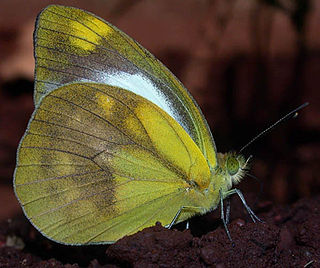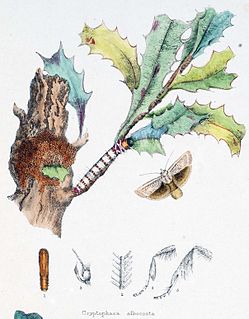Related Research Articles

Cepora nadina, the lesser gull, is a small to medium-sized butterfly of the family Pieridae, that is, the yellows and whites. The species was first described by Hippolyte Lucas in 1852. It is native to Sri Lanka, India, Myanmar, Hainan, and southeast Asia.
Ebbepterote is a monotypic moth genus in the family Eupterotidae. It was erected by Rolf G. Oberprieler, Wolfgang A. Nässig and Edward David Edwards in 2003. Its only species, Ebbepterote expansa, was described by Thomas Pennington Lucas in 1891. It is found in Australia, where it has been recorded from Queensland.
Melaleuca phratra is a plant in the myrtle family, Myrtaceae and is endemic to Queensland in Australia. It is a large shrub similar to Melaleuca paludicola but has flower spikes that are a shade of pink.

Melaleuca rugulosa, commonly known as scarlet bottlebrush, is a plant in the myrtle family, Myrtaceae and is endemic to South Australia and Victoria in Australia. It is a shrub with an open straggly habit, stiff, sharply pointed leaves and bright red bottlebrush flowers tipped with yellow in summer.

Melaleuca salicina, commonly known as willow bottlebrush, is a plant in the myrtle family Myrtaceae, and is endemic to eastern Australia. Some Australian state herbaria continue to use the name Callistemon salignus, a name that is accepted by the Australian Plant Census. It is a shrub or small tree with soft foliage, pink new growth, white papery bark and spikes of usually white or creamy bottlebrush flowers in spring.
Filatima ochreosuffusella is a moth of the family Gelechiidae. It is found in North America, where it has been recorded from Texas.
Catoryctis truncata is a moth in the family Xyloryctidae. It was described by Thomas Pennington Lucas in 1902. It is found in Australia, where it has been recorded from New South Wales and Queensland.
Cryptophasa oecodoma is a moth in the family Xyloryctidae. It was described by Edward Meyrick in 1930. It is found on New Guinea.
Cryptophasa nephrosema is a moth in the family Xyloryctidae. It was described by Turner in 1898. It is found in Australia, where it has been recorded from Queensland and the Northern Territory.
Cryptophasa platypedimela is a moth in the family Xyloryctidae. It was described by Oswald Bertram Lower in 1894. It is found in Australia, where it has been recorded from Queensland.
Cryptophasa isoneura is a moth in the family Xyloryctidae. It was described by Oswald Bertram Lower in 1902. It is found in Australia, where it has been recorded from Queensland, South Australia and Victoria.

Cryptophasa albacosta, the small fruit tree borer, is a moth in the family Xyloryctidae. It was described by John Lewin in 1805. It is found in Australia, where it has been recorded from New South Wales, Queensland, South Australia, Tasmania and Victoria.
Cryptophasa tecta is a moth in the family Xyloryctidae. It was described by Thomas Pennington Lucas in 1894. It is found in Australia, where it has been recorded from the Northern Territory and Queensland.
Cryptophasa phycidoides is a moth in the family Xyloryctidae. It was described by Thomas Pennington Lucas in 1901. It is found in Australia, where it has been recorded from New South Wales and Queensland.
Cryptophasa cannea is a moth in the family Xyloryctidae. It was described by Thomas Pennington Lucas in 1901. It is found in Australia, where it has been recorded from Queensland.
Cryptophasa molaris is a moth in the family Xyloryctidae. It was described by Thomas Pennington Lucas in 1900. It is found in Australia, where it has been recorded from New South Wales and Queensland.
Pilostibes serpta is a moth in the family Xyloryctidae. It was described by Thomas Pennington Lucas in 1901. It is found in Australia, where it has been recorded from New South Wales, Queensland, South Australia and Western Australia.
Paralecta tinctoria is a moth in the family Xyloryctidae. It was described by Thomas Pennington Lucas in 1894. It is found in Australia, where it has been recorded from Queensland.
Xylorycta corticana is a moth in the family Xyloryctidae. It was described by Thomas Pennington Lucas in 1901. It is found in Australia, where it has been recorded from Queensland.
Zauclophora procellosa is a moth in the family Xyloryctidae. It was described by Thomas Pennington Lucas in 1901. It is found in Australia, where it has been recorded from Queensland.
References
- ↑ Savela, Markku (25 April 2016). "Cryptophasa nubila (Lucas, 1894)". Lepidoptera and Some Other Life Forms. Retrieved July 13, 2020.
- ↑ McMillan, Ian (30 August 2010). "Cryptophasa nubila (T.P. Lucas, 1894)". Xyloryctine Moths of Australia. Retrieved 13 July 2020.
| This article on a moth of the family Xyloryctidae is a stub. You can help Wikipedia by expanding it. |